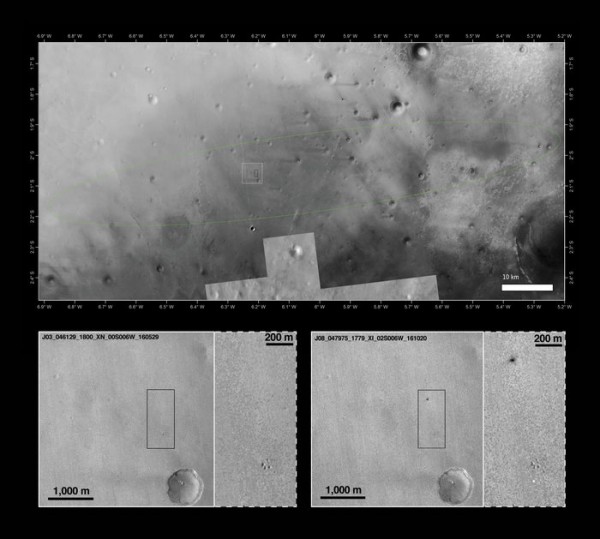By Ana Verayo, | October 26, 2016

The landing site of the Schiaparelli module within the predicted landing ellipse in a mosaic of images from the Context Camera (CTX) on NASA's Mars Reconnaissance Orbiter and the Thermal Emission Imaging System (THEMIS) on NASA's 2001 Mars Odyssey orbiter
Europe's Martian lander crashed upon touchdown on Mars last week. Mission scientists believe that a software glitch on the ExoMars Schiaparelli lander may have caused it to explode and crash on the surface of the Red Planet.
Like Us on Facebook
A new report citing European Space Agency's head of solar and planetary missions, Andrea Accomazzo, reveals how a software issue is the most likely culprit for this crash. He blamed the incident on an anomaly on Schiaparelli's onboard computers.
Accomazzo explained that a software issue could be easier to fix than a technological issue. He noted that if this was a technological issue, then the team would need to re-evaluate everything. However, this is not expected to be the case.
The main goal of the ExoMars mission is to search for signs of life, particularly the gas methane which is being emitted by microbial life as well as biological processes on the alien world.
The Schiaparelli lander was deployed by its mothership, ESA's Trace Gas Orbiter, which is now successfully orbiting Mars. The descent took two days for the lander, and while the orbiter was successfully inserted into orbit, the lander did not successfully make a soft landing, failing to send a signal and losing contact a minute before touchdown.
Last Friday, October 21, NASA's Mars Reconnaissance Orbiter detected the fallen Schiaparelli lander within the target landing site with the tell-tale signs of scorch marks from the explosion.
The ESA's investigation is still ongoing. However, these new images suggest that the lander most likely exploded on impact since its propellant tanks were still full.
According to ExoMars project scientist Jorge Vago, the lander's parachutes and heat shield were deployed ahead of time, and due to this computer glitch, the thrusters fired for only three seconds as opposed to 30 seconds. This might mean that the lander was still too high during this crucial burn that it just dropped within a mile from the surface.
The second phase of the ExoMars mission is scheduled for 2020. ESA will send another lander-rover after collecting data from the Trace Gas Orbiter and whatever data is obtained from the Schiaparelli.
-
Use of Coronavirus Pandemic Drones Raises Privacy Concerns: Drones Spread Fear, Local Officials Say

-
Coronavirus Hampers The Delivery Of Lockheed Martin F-35 Stealth Fighters For 2020

-
Instagram Speeds Up Plans to Add Account Memorialization Feature Due to COVID-19 Deaths

-
NASA: Perseverance Plans to Bring 'Mars Rock' to Earth in 2031

-
600 Dead And 3,000 In The Hospital as Iranians Believed Drinking High-Concentrations of Alcohol Can Cure The Coronavirus

-
600 Dead And 3,000 In The Hospital as Iranians Believed Drinking High-Concentrations of Alcohol Can Cure The Coronavirus

-
COVID-19: Doctors, Nurses Use Virtual Reality to Learn New Skills in Treating Coronavirus Patients







